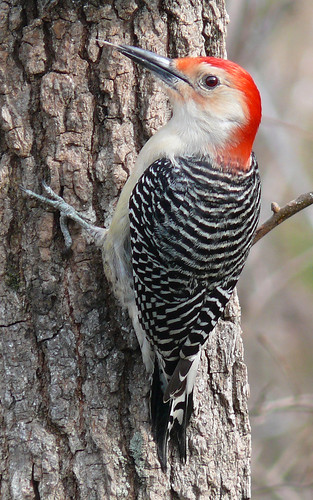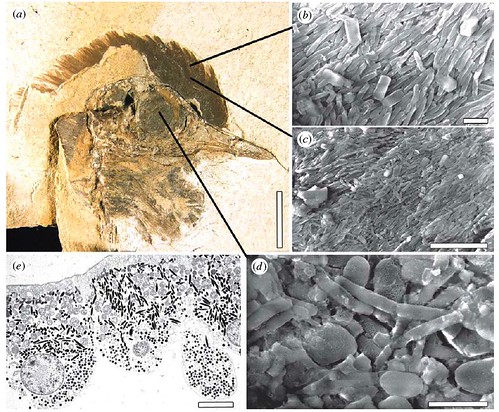tags: researchblogging.org, melanosomes, plumage color, feather color, fossil preservation, birds, dinosaur, Jakob Vinther
When looking at paintings and reconstructions of fossil birds and dinosaurs, people often ask "how do you know what color they were?" Well, we didn't. However, a new paper was just published in Biology Letters that explores the possibility of deciphering the actual color of fossilized plumage and makes a startling discovery: scientists can identify at least some of the original colors in ancient feathers.
In sharp contrast to mammals, whose colorations are really very boring, birds are colorful -- many species are stunningly so. But colors are expensive and wasteful to produce if they can't be used to communicate a particular message that can be seen by the intended recipient. In fact, birds evolved colors to send signals to other birds. They also evolved the visual structures in their eyes necessary to perceive those colors and they developed behaviors designed to draw attention to their plumage coloration. Which leads one to ask; what colors were ancient birds and feathered dinosaurs?
Paleontologists have found feather fossils in roughly 50 rock formations ranging from 200 million years old to about 2 million years old. Yale University graduate student, Jakob Vinther, is examining fossilized bird feathers and during his studies, he noticed that some feather fossils have dark and light stripes. These organic "fingerprints" in fossilized feathers have often been assumed to result from carbon contained inside ancient bacteria that were fossilized as the feathers decayed, but Vinther compared the microstructures in these stripes to those found in modern day bird feathers and discovered that they are almost identical to melanomes.
Melanosomes are intracellular organelles that contain the melanins, a class of organic compounds that are the most common of all light-absorbing pigments found in protists, plants and animals. These pigments are the source for a variety of colors ranging from yellows to black.
"Feather melanin is responsible for rusty-red to jet-black colors, and a regular ordering of melanin even produces glossy iridescence," observes Vinther.
Melanosomes are surrounded by a lipid membrane and are generally shaped like a sausage (figure 1);
Figure 1: Cretaceous feather ultrastructure compared with that in a living bird. (a) Feather from the Crato Formation, Early Cretaceous, Brazil (Leicester University, U.K., Geology Department, LEIUG 115562) showing colour bands; margins of colour bands are similar to those found in living birds and barbules are clearly preserved (i). (b) Dark bands, composed of aligned eumelanosomes, contrast with (c) light areas that reveal only the rock matrix. (d) A broken barbule from a modern Red-winged Blackbird (A. phoeniceus, Aves: Icteridae, Yale Peabody Museum 1047) reveals eumelanosomes aligned along the barbule enclosed in a keratin matrix. Scale bars, (a) 3 mm, insert 1 mm; (b) 1 μm; (c) 10 μm; (d) 1 μm. DOI: 10.1098/rsbl.2008.0302 [larger view].
To do this work, Vinther and his colleagues used a scanning electron microscope to analyze a striped feather fossil found in 100 million-year-old Brazilian rock. The dark bands of the feather contained pigment-bearing structures that looked similar to the melanosomes found in a black feather from a red-winged blackbird, Agelaius phoeniceus, whereas the light bands revealed only the surface of the rock.
Were these structures present in other fossilized feathers from different times? To answer this question, Vinther and his colleagues used the same technique to analyze 55 million year old feathers from a bird fossil originally unearthed in Denmark. They found similar sausage-like structures in the feathers surrounding the skull of this bird (figure 2);
Figure 2: (a) Skull of undescribed bird from the Fur Formation, Early Eocene, Denmark (Danekræ 200, MGUH 28.929), preserving feathers and the eye as an organic film. (b,c) Details of the feather region showing aligned eumelanosomes. (d) Detail of the eye showing elongate and oblate eumelanosomes. (e) TEM of a section through the retina of a modern bird (Caprimulgus vociferous, Caprimulgidae). Scale bars, (a) 10 mm; (b) 1 μm; (c) 5 μm; (d) 1 μm; (e) 5 μm. DOI: 10.1098/rsbl.2008.0302 [larger view].
Interestingly, they also discovered melanosomes in the fossil bird's eyes, and found they are similar to melanosomes in the eyes of modern birds, suggesting that scientists might also be able to identify colors in fossilized animal eyes.
Vinther and his colleagues think they can identify brown, red, buff and even iridescent colors. Certainly, other studies of modern birds have revealed that a variety of plumage colors result from distinct arrangements of their melanosomes, so it is plausible to think that scientists could identify more ornate plumage colors in ancient birds and dinosaurs.
"Birds frequently have spectacularly colored plumage which are often used in camouflage and courtship display," Vinther noted. "Feather melanin is responsible for rusty-red to jet-black colors and a regular ordering of melanin even produces glossy iridescence. Understanding these organic remains in fossil feathers also demonstrates that melanin can resist decay for millions of years."
The next step is to investigate the structure of fossilized feathers from an ancient bird thought to be closely related to a living bird with varied and colourful plumage.
"With luck the microstructure of feathers from different parts of the fossil will vary corresponding to different original colors," notes coauthor Derek Briggs, a paleontologist at Yale University.
This feature of melanin would allow scientists to begin deciphering a variety of behaviors that accompany plumage colorations, thereby adding detail to our knowledge of the lives led by fossil birds and dinosaurs.
"We might .. be able to tell whether they have sexual dimorphisms -- whether males were more spectacularly coloured than females," Vinther speculates.
Sources
Vinther, J., Briggs, D.E., Prum, R.O., Saranathan, V. (2008). The colour of fossil feathers. Biology Letters, -1(-1), -1--1. DOI: 10.1098/rsbl.2008.0302.
Yale University press release (quotes).




I've been waiting for them to figure this one out. They should be able to identify colors on some insects too.
Thanks to grrlscientist for an excellent review. I am amazed how much interest this story could spur in the media. I usually work on Cambrian invertebrates and I haven´t been able to create as much interest about them compared to colors in dinosaur and bird feathers. I would like to rephrase Karl Marx´statement into "Dinosaurs are opium for the people". Clearly I chose the wrong business if I want to be famous (but who really wants to be that?).
To reply to Sena´s comment, we will probably not be able to say that much about insect colors. They do have fossilized melanin and colorbands, but it does not seem as if the melanin is retained inside the melanosomes, which we can recognize under the SEM. Thus, there is a chance that the melanin granules will be too small to be observed. I have seen fossilized melanin granules in fossil Squid ink under the SEM, but I looked at some TEM´s of some insects together with Derek Briggs and it does not look like the melanin granules are big enough to be seen under the SEM.
See by the way this example of color patterns in an Eocene insect that I found in the same locality as the bird from Denmark and a modern bug from China.
http://www.jakobvinther.com/insect%20colour%20pattern.jpg
With respect to the melanin we found in the eyes, we think it is the melanin behind the retina and not the iris. Thus it will not be so informative about the eye colour unless you find a distinct outline of the iris and can identify melanosomes in it.
Jakob,
The resolution of modern field emission SEM's is a lot better than you might think. Resolution of a couple of nanometers is pretty common, and Hitachi claims a resolution of 0.4 nm for their best instrument.
Mr. Vinther -
Are there fossils of feathers where there is well preserved (or relatively well preserved) B-keratin? I am wondering if tell-tale evidence (or even strong evidence) of other pigments might survive, even if only as remnants, "echoes" or "shadows" or "scars" (I am not a scientist, so my terminology is not very precise...sorry) or other markers; and including if those remnants or molecules might be in association with melanin pigments or alone as some trace in the non-melanin areas?
Clapping,
Chardyspal
Dr. Vinther -
Are there fossils of feathers where there is well preserved (or relatively well preserved) B-keratin? I am wondering if tell-tale evidence (or even strong evidence) of other pigments might survive, even if only as remnants, "echoes" or "shadows" or "scars" (I am not a scientist, so my terminology is not very precise...sorry) or other markers; and including if those remnants or molecules might be in association with melanin pigments or alone as some type of trace in the non-melanin areas?
Clapping,
Chardyspal
Kelly Miller
Thanks for the Info. That sounds pretty cool. I have also seen some pretty good images with atomic force microscopes of melanin. Our limit sofar has been that we have some very precious fossils that we can not chip pieces of or coat with carbon or gold. Therefore, we have been limited to using environmental chamber microscopy and uncoated specimens. This creates a lot of problems and often when I zoomed close to the fossil, I would get a lot of charging and everything would be bouncing around. I studied some melanin granules from fossil squid ink sacs and had good success by coating them with gold (they have a diameter of about 180 nm).
Chardyspal, Mr. or Dr. whatever, just call me Jakob I am only a student!
I haven´t been able to find any B keratin in feathers. Proteins are not stable in geologic environments and would not be preserved readily. I know that Mary Schweitzer have detected proteins inside dinosaur bones and I need to look at these papers in detail. Melanin is composed of Dihydroxyindolecarboxylic acid in oligomeric stacks by the way. Some indications of fossil dinos with toe nails have also been reported.
I am not too sure about any other pigments, like for example B carotenoids, for example. I dont know how they would look like and whether they have a chemical composition that would make them into something stable over geologic times. I know that fossil mollusk shells are preserved with colorbands and they have been proven to be fluorescent, which I believe can be ascribed to a pigment called tetrapyrrole, therefore there might be more pigments out there. Melanin bands have also been described in mollusk shells.
Insects have been described from the Eocene Messel formation (40 million years) that have the structural coloration preserved in the degraded chitin layers. Thus you frequently find fossil beetles with metallic luster!!!
Hi Jakob,
Congratulations on the paper. I just wanted to thank you for taking the time to answer questions here. It may seem like a small thing, but it's not.
Good luck with your research.